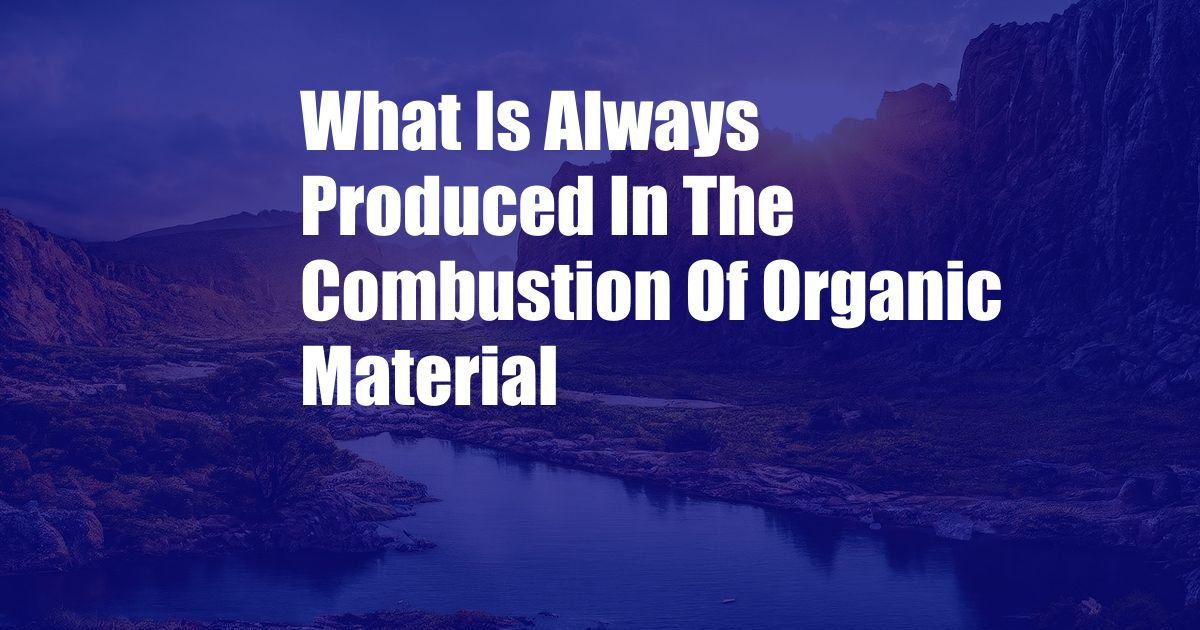
What is Always Produced in the Combustion of Organic Material?
Fire holds a captivating allure for many. Whether it’s a cozy campfire on a chilly night or the dramatic spectacle of a forest blaze, fire’s dance has mesmerized humans since time immemorial. However, beyond its mesmerizing beauty, fire is a complex chemical reaction that transforms organic matter into various substances, one of which is always present: carbon dioxide.
Carbon dioxide, a colorless, odorless gas, plays a crucial role in the Earth’s atmosphere. It’s an essential greenhouse gas that helps regulate the planet’s temperature, making it habitable for life. Moreover, carbon dioxide serves as a vital resource for plants through photosynthesis, providing the building blocks for their growth and sustenance. Despite its beneficial aspects, excessive carbon dioxide emissions have contributed to global climate change, highlighting the delicate balance of its role in our ecosystem.
Combustion: The Process of Fire
Combustion, the chemical process behind fire, entails the rapid oxidation of a fuel, usually an organic material such as wood, paper, or fossil fuels. During combustion, the fuel reacts with oxygen, releasing energy in the form of heat and light. However, combustion doesn’t simply produce energy; it also results in the formation of various substances as byproducts. The precise composition of these byproducts depends on the fuel’s chemical makeup and the combustion conditions.
Carbon Dioxide: An Invariable Combustion Product
Regardless of the type of organic fuel undergoing combustion, one product is always present: carbon dioxide (CO2). This is because carbon is an inherent part of all organic materials. When these materials burn, the carbon atoms combine with oxygen to form carbon dioxide molecules. The release of carbon dioxide into the atmosphere is a natural consequence of combustion, and it has played a significant role in shaping the Earth’s climate over millions of years.
The amount of carbon dioxide produced during combustion depends on several factors, including the fuel’s carbon content, the amount of oxygen available, and the combustion efficiency. Complete combustion, where all the fuel’s carbon is converted into carbon dioxide, is ideal for minimizing carbon emissions. However, incomplete combustion, often caused by insufficient oxygen, can lead to the formation of carbon monoxide (CO), a toxic gas.
Beyond Carbon Dioxide: Other Combustion Products
While carbon dioxide is an inevitable product of organic material combustion, other substances can also be produced, depending on the fuel and combustion conditions. These may include:
- Water vapor (H2O): Formed when hydrogen atoms in the fuel combine with oxygen
- Carbon monoxide (CO): A toxic gas produced during incomplete combustion
- Nitrogen oxides (NOx): Formed when nitrogen in the fuel or air reacts with oxygen
- Sulfur oxides (SOx): Produced when sulfur-containing fuels, such as coal, are burned
- Particulate matter (PM): Tiny particles of soot, ash, and other unburned material
Environmental Implications of Combustion
The combustion of organic materials has a profound impact on the environment, both positive and negative. On the positive side, combustion provides energy for various applications, including electricity generation, transportation, and industrial processes. It also plays a role in waste management, as the incineration of waste can reduce landfill volume and recover energy.
However, the release of combustion products into the atmosphere can have adverse environmental effects. Carbon dioxide contributes to global warming, while other pollutants, such as nitrogen oxides and particulate matter, can cause respiratory problems and other health issues. Additionally, the burning of fossil fuels releases harmful pollutants that contribute to acid rain and smog.
Mitigating the Environmental Impacts of Combustion
Recognizing the environmental challenges associated with combustion, various measures can be taken to mitigate its impact. These include:
- Promoting renewable energy sources, such as solar and wind power, to reduce reliance on fossil fuels
- Improving combustion efficiency to minimize the production of harmful pollutants
- Implementing emission control technologies, such as catalytic converters and scrubbers, to reduce the release of pollutants into the atmosphere
- Promoting sustainable waste management practices, including recycling and composting, to reduce the need for incineration
Conclusion
The combustion of organic material is a complex process that produces various substances, including carbon dioxide. While carbon dioxide is a natural byproduct of combustion, its excessive emissions can contribute to environmental problems. Understanding the science behind combustion and implementing mitigation measures are crucial for harnessing its benefits while minimizing its negative impact on the planet.
Is the topic of combustion and carbon dioxide emissions of interest to you? Share your thoughts and questions in the comments below.